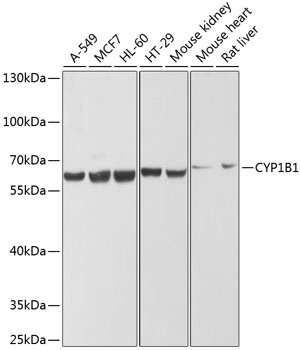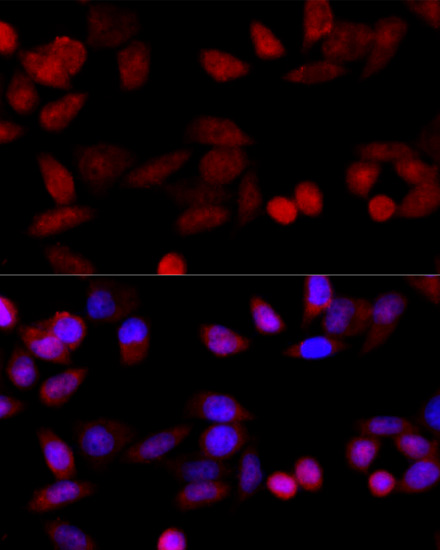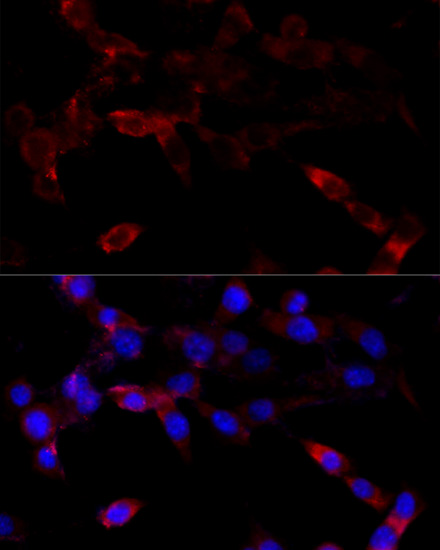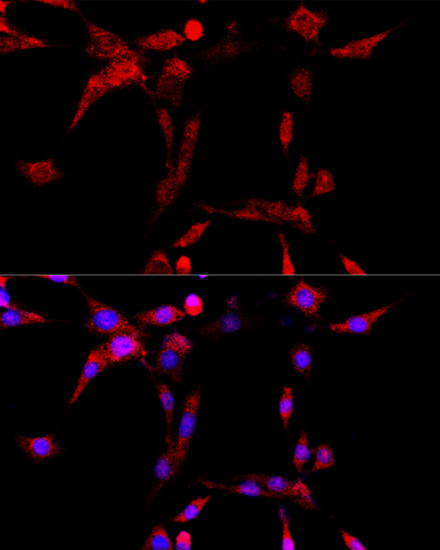-
Product Name
CYP1B1 Polyclonal Antibody
- Documents
-
Description
Polyclonal antibody to CYP1B1
-
Tested applications
WB, IHC, IF
-
Species reactivity
Human, Mouse, Rat
-
Alternative names
CYP1B1 antibody; ASGD6 antibody; CP1B antibody; CYPIB1 antibody; GLC3A antibody; P4501B1 antibody; cytochrome P450 1B1 antibody
-
Isotype
Rabbit IgG
-
Preparation
Antigen: Recombinant fusion protein containing a sequence corresponding to amino acids 1-260 of human CYP1B1 (NP_000095.2).
-
Clonality
Polyclonal
-
Formulation
PBS with 0.02% sodium azide, 50% glycerol, pH7.3.
-
Storage instructions
Store at -20℃. Avoid freeze / thaw cycles.
-
Applications
WB 1:500 - 1:2000
IHC 1:50 - 1:100
IF 1:50 - 1:100 -
Validations

Western blot - CYP1B1 Polyclonal Antibody
Western blot analysis of extracts of various cell lines, using CYP1B1 antibody at 1:1000 dilution.Secondary antibody: HRP Goat Anti-Rabbit IgG (H+L) at 1:10000 dilution.Lysates/proteins: 25ug per lane.Blocking buffer: 3% nonfat dry milk in TBST.Detection: ECL Enhanced Kit .Exposure time: 5s.

Immunofluorescence - CYP1B1 Polyclonal Antibody
Immunofluorescence analysis of HeLa cells using CYP1B1 antibody at dilution of 1:100 (40x lens). Blue: DAPI for nuclear staining.

Immunofluorescence - CYP1B1 Polyclonal Antibody
Immunofluorescence analysis of NIH/3T3 cells using CYP1B1 antibody at dilution of 1:100 (40x lens). Blue: DAPI for nuclear staining.

Immunofluorescence - CYP1B1 Polyclonal Antibody
Immunofluorescence analysis of PC-12 cells using CYP1B1 antibody at dilution of 1:100 (40x lens). Blue: DAPI for nuclear staining.
-
Background
Cytochromes P450 are a group of heme-thiolate monooxygenases. In liver microsomes, this enzyme is involved in an NADPH-dependent electron transport pathway. It oxidizes a variety of structurally unrelated compounds, including steroids, fatty acids, retinoid and xenobiotics. Preferentially oxidizes 17beta-estradiol to the carcinogenic 4-hydroxy derivative, and a variety of procarcinogenic compounds to their activated forms, including polycyclic aromatic hydrocarbons. Promotes angiogenesis by removing cellular oxygenation products, thereby decreasing oxidative stress, release of antiangiogenic factor THBS2, then allowing endothelial cells migration, cell adhesion and capillary morphogenesis. These changes are concommitant with the endothelial nitric oxide synthase activity and nitric oxide synthesis. Plays an important role in the regulation of perivascular cell proliferation, migration, and survival through modulation of the intracellular oxidative state and NF-kappa-B expression and/or activity, during angiogenesis. Contributes to oxidative homeostasis and ultrastructural organization and function of trabecular meshwork tissue through modulation of POSTN expression.
Related Products / Services
Please note: All products are "FOR RESEARCH USE ONLY AND ARE NOT INTENDED FOR DIAGNOSTIC OR THERAPEUTIC USE"
